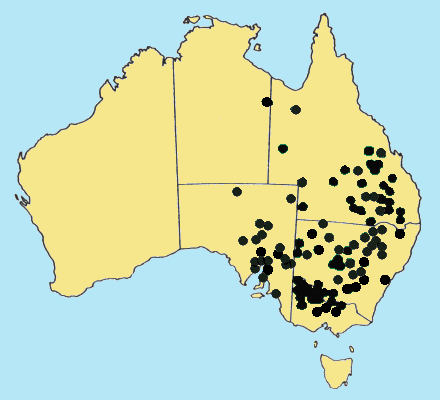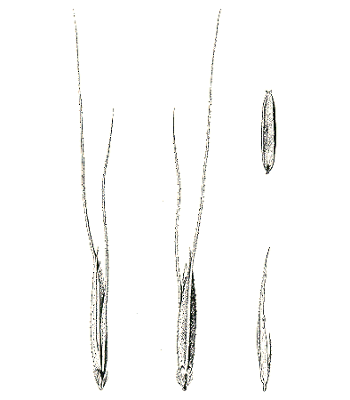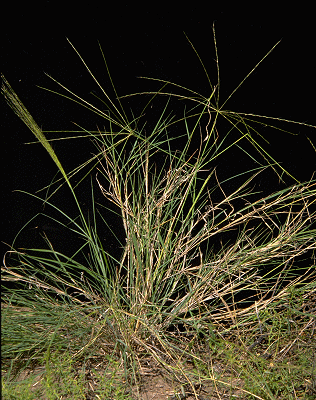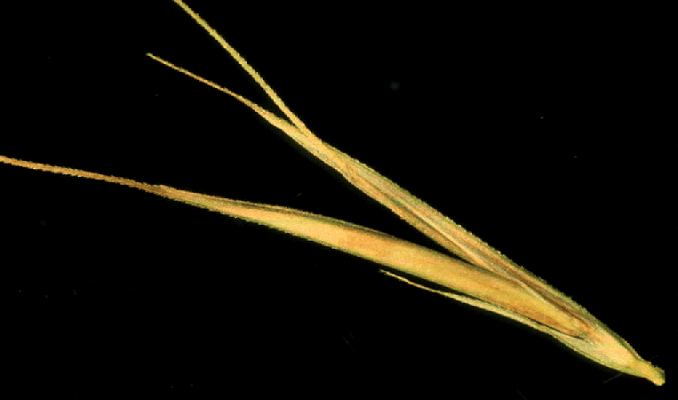Enteropogon acicularis (Lindl.)
Lazarides. Austral. J. Bot. Supp. 5: 31 (1972).
Classification. (GPWG 2001) : Subfamily Chloridoideae. Cynodonteae.
Basionym and/or
Replacement Name: Chloris
acicularis Lindl., J. Exped. Trop. Australia 33 (1848).
Type of Basionym or
Protologue Information: HT: Mitchell 115, 1846, Australia: New South Wales:
Bogan River (CGE; photo of holotype at BRI).
Recent synonyms:
Chloris acicularis, C. moorei.
Key references
(books and floras): [1878] G.Bentham, Flora Australiensis 7 (612 as Chloris
acicularis), [1952] C.A.Gardner, Flora of Western Australia 1 Gramineae
(218 as Chloris), [1981] M.Lazarides in J.Jessop (ed)., Flora of
Central Australia (465), [2000] I.D.Cowie, P.S.Short, M. Osterkamp Madsen, Floodplain
Flora, [2002] D.Sharp & B.K.Simon, AusGrass, Grasses of Australia,
[2006] J.Jessop, G.R.M.Dashorst, F.M.James, Grasses of South Australia
(358), [2008] S.W.L.Jacobs, R.D.B.Walley & D.J.B.Wheeler, Grasses of New
South Wales (243).
Illustrations:
[1952] C.A.Gardner, Flora of Western Australia 1 Gramineae (221,
Pl.65 as Chloris), [2005] K.Mallet (ed.), Flora of Australia 44B:
Poaceae 3 (Fig. 49I-L), [2006] J.Jessop, G.R.M.Dashorst, F.M.James, Grasses
of South Australia (358, fig. 288),
[2008] S.W.L.Jacobs, R.D.B.Whalley & D.J.B.Wheeler, Grasses of New South
Wales, 4th edn (243).
Habit.
Perennial. Culms erect or geniculately ascending, stature robust to moderate,
25–100 cm tall, 3–6 -noded. Lateral branches simple or branched. Leaves mostly
basal. Ligule an eciliate membrane, 1 mm long. Leaf-blades curled, flat, 5–20
cm long, 1.8–4 mm wide.
Inflorescence.
Inflorescence digitate, with spicate branches.
Spikelets.
Spikelets sessile. Fertile spikelets 1 or more flowered, with 1 fertile floret,
comprising 1 fertile floret(s), with diminished florets at the apex,
lanceolate, laterally compressed, 7–11 mm long.
Glumes. Glumes
similar, thinner than fertile lemma. Lower glume linear, membranous, without
keels, 1 -nerved. Lower glume apex mucronate or awned. Upper glume linear,
4.5–11 mm long, membranous, without keels, 1 -nerved. Upper glume apex awned.
Florets.
Fertile lemma 5.5–9.2 mm long, keeled, 3 -nerved. Lemma apex entire or dentate,
awned, 1 -awned. Median (principal) awn from a sinus, 8–22 mm long overall.
Palea 2 -nerved. Anthers 3.
Continental
Distribution: Australasia.
Australian
Distribution: Western Australia, Northern Territory, South Australia,
Queensland, New South Wales, Victoria.
Western Australia:
Fitzgerald, Hall. Canning, Carnegie, Giles, Helms, Fortescue, Ashburton,
Carnarvon, Austin. Eucla, Irwin, Coolgardie. Northern Territory:
Victoria River, Central Australia North, Central Australia South. South
Australia: North-western, Lake Eyre, Gairdner-Torrens Basin, Flinders
Ranges, Eastern, Eyre Peninsula, Northern Lofty, Murray, Southern Lofty. Queensland:
Burke, Burnett, Darling Downs, Gregory North, Leichhardt, Maranoa, Mitchell,
Moreton, North Kennedy, Port Curtis, South Kennedy, Warrego, Gregory South. New
South Wales: Central Coast, North-Western Slopes, Central-Western Slopes,
South-Western Slopes, North-Western Plains, South-Western Plains, North Far
Western Plains, South Far Western Plains. Victoria: Murray Mallee,
Riverina, Wimmera.
Notes.
Specimens of E. acicularis are distinguished from the closely related E.
ramosus by having generally more spikes, the foliage mostly at the base of
the plant, less branching, and usually by the presence of a contra-ligule which
may vary from a discontinuous pubescence across the collar region of only some
of the leaves to an indurated membranous-ciliolate protruberance present on all
leaves. A few collections appear to lack a contra-ligule, but at least some of
the leaf blades, sheaths and/or orifice are hairy, whereas E. ramosus is
always completely glabrous.
Through
the SE quarter of Qld, inland N.S.W., northern Vic., and north-central S.A.
Occurs on heavier-textured red, brown, grey and black soils in summer rainfall
areas, particularly where there is melon-hole development, in brigalow (Acacia
harpophylla) country, Eucalyptus forest, or mulga (Acacia aneura).
In winter rainfall areas, known from sandy, loam or clay soils, in grassland on
floodplains, in savanna or mallee woodland, or in forest; overstorey species
include ironbark (Eucalyptus crebra), Eucalyptus coolabah, Callitris
collumellaris and poplar box (Eucalyptus populnea).


AVH Oct 2012




